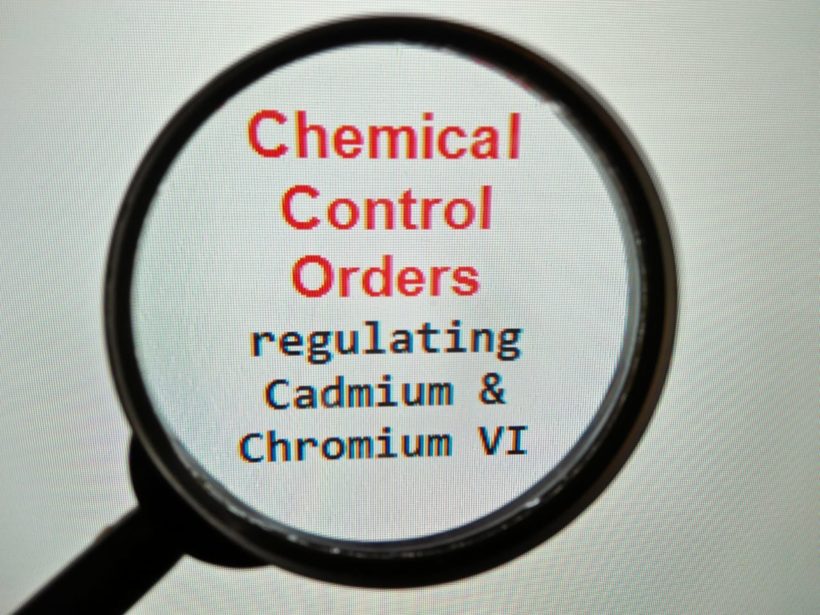7 November 2021, Quezon City. The Government of the Philippines has imposed new policies tightening regulations on the industrial uses of cancer-causing cadmium and hexavalent chromium to protect human health and the environment.
The toxics watchdog group EcoWaste Coalition, which actively participated in the consultative processes, welcomed the new regulations targeting substances belonging to the Philippine Priority Chemicals List (PCL), which enumerates chemicals determined by the authorities to potentially pose unreasonable risk to public health, workplace, and the environment.
Through separate Chemical Control Orders (CCOs) published last month, the Department of Environment and Natural Resources (DENR) directed persons or entities engaged in the importation, manufacture, distribution and industrial use of cadmium and its compounds, as well as hexavalent chromium (or chromium VI) compounds, to register with and obtain importation clearance from the Environmental Management Bureau (EMB).
The “CCO for Cadmium and Cadmium Compounds” was published on October 22 and will take effect on November 6, while the “CCO for Chromium VI Compounds” was published on October 26 and will enter into force on November 10. Both CCOs were signed by DENR Secretary Roy Cimatu last May 6.
Concerned persons or entities are required to comply with the requirements pertaining to importation, manufacturing, handling, transport, treatment, storage and disposal as per DENR Administrative Order 1992-29, which provides for the Implementing Rules and Regulations of Republic Act No. 6969, also known as the “Toxic Substances and Hazardous and Nuclear Wastes Control Act of 1990.” They will also be required to submit chemical management, emergency and contingency plans, conduct workers’ safety training, as well as conform to the provisions of the Globally Harmonized System (GHS) of classification and labeling of chemicals.
“We welcome the CCO regulating industry use of cadmium as this can contribute to safeguarding the health of workers and the general public from the adverse effects of exposure to this highly toxic element,” said Thony Dizon, Chemical Safety Campaigner, EcoWaste Coalition.
“As the CCO does not cover cadmium and cadmium compounds in batteries, ceramics, cosmetics, electronics, jewelry, plastics, toys and others, we hope other regulatory agencies will adopt and/or enforce health-protective controls or restrictions on the cadmium content in products and materials under their jurisdiction to protect consumers and the environment,” he added.
“We also see the promulgation of the chromium VI CCO as a positive step that will hopefully lead to the replacement of this compound in industrial processes, especially when feasible and non-toxic alternatives have been identified,” Dizon also said.
In a position paper submitted to the Environmental Management Bureau (EMB) in March 2017, the EcoWaste Coalition cited prohibitions on Cr(VI) in other countries. For example, the REACH Regulation of the European Chemicals Agency banned the use of Cr(VI) for surface treatment by September 2017. REACH refers to the regulations on the Registration, Evaluation, Authorization and Restriction of Chemicals in the European Union (EU). The EU likewise phased out corrosion-resisting paint additives in January 2019.
Under the CCO, the use of Cr(VI) will be “strictly regulated” in activities relating to the manufacture of pigments, inks, textile dyes, protective coatings and paints, stainless steel, and electronic equipment or electroplating. The strict regulation will also apply to the operation of laboratory facilities and tanneries.
The DENR through the EMB may develop a phase-out plan for uses of cadmium and chromium VI in consultation with other agencies and stakeholders as stated in the CCOs.
Cadmium is classified as one of the “10 chemicals of major public health concern” by the World Health Organization (WHO). “Cadmium exerts toxic effects on the kidney, the skeletal system and the respiratory system and is classified as a human carcinogen,” as said by WHO.
According to the US Occupational Safety and Health Administration (OSHA), “Cr(VI) is known to cause cancer. In addition, it targets the respiratory system, kidneys, liver, skin and eyes.” OSHA has warned that “industrial processes that involve chromium can result in worker exposure to toxic hexavalent chromium.”
Reference:
https://chemical.emb.gov.ph/wp-content/uploads/2021/05/DAO-2021-08-CCO-Cadmium.pdf
https://chemical.emb.gov.ph/wp-content/uploads/2021/05/DAO-2021-09-CCO-Chromium-VI.pdf
https://www.who.int/teams/environment-climate-change-and-health/chemical-safety-and-health/health-impacts/chemicals/cadmium
https://www.osha.gov/hexavalent-chromium










